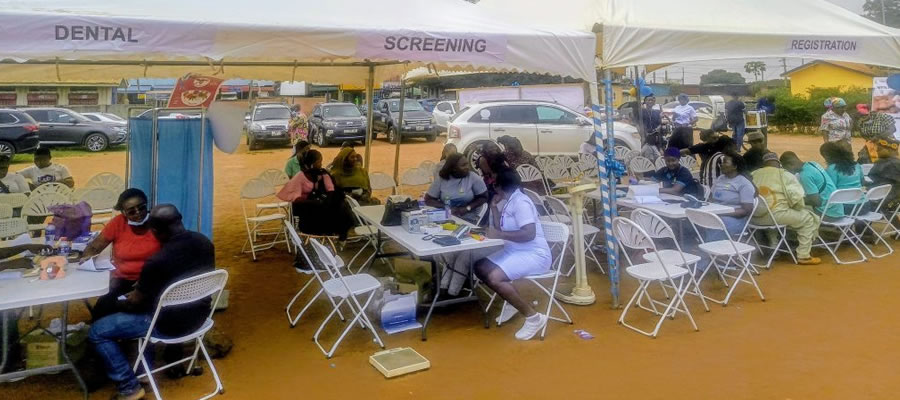

Persons with disabilities (PWD) have been defined as those who are unable to or are restricted in the performance of specific tasks/activities due to loss of function of some part of the body as a result of impairment or malformation (Ghana Statistical Service, 2012). Governments over the years have formulated policies aimed at creating a better livelihood and opportunities for persons with disabilities. This chapter discusses the characteristics of population with disability, types of disability, distribution by type of locality, disability and activity and disability, education and literacy for PWDs within the La Nkwantanang Madina Municipality.
Types of Disability
Table 6.1, shows the distribution of PWDs over the different types of disabilities in the Municipality. Of all the cases of disability, sight impairment constitutes the highest percentage (42.1%) with more than half being females (55.5%). Also, the proportion of persons living with physical disability (22.9%) is quite significant. This is followed by intellectual (19.8%) disability. Speech impairment (11.2%) has the least proportion of PWDs in the Municipality. In general, with the exception of Speech and Physical impairment, the distribution of male PWDs over the different types of disabilities exhibits higher proportions compared to that of the female PWDs.
Population with Disability
It should be noted that, data on disability is a multiple response data and therefore total types of disability will not produce population with disability. Table 6.1 shows that, there are 3,068 persons with disability (PWD) accounting for 2.7 percent of the entire population of La Nkwantanang Madina Municipality. Of this total, about 52.0 percent are females while 48.0 percent are males. Similarly, the proportion of female population that are PWDs is slightly higher than that of the male population (2.8% against 2.7%).
Distribution by Type of Locality and sex
The locality of residence of persons with disability has impact on their ability to access social services. This is particularly critical in Ghana, where most of the social service agencies are concentrated in the urban areas. As shown in Table 6.2, disability varies by locality of residence in the Municipality. Overall, the table indicates that the population of PWDs living in urban localities (2,496) is almost five times the population of PWDs living in the rural localities (572). The distribution of PWDs over the types of disabilities varies at the locality.
While sight impairment (47.6%) is the commonest type of disability in the urban communities, intellectual challenge is rather the case in the rural communities (52.6%). However, in the urban areas, higher proportion of female PWDs suffer from sight impairment compared to their male counterparts (49.3% against 45.4%). The reverse is the case in the rural, as male PWDs dominate in the commonest disability (intellectual) (56.9% against 46.3%). The high proportion of PWDs in the urban localities of the Municipality may be attributable to lack of economic opportunities in the rural areas, giving rise to a syndrome that motivate PWDs to beg for arms rather than being involved in economic ventures.
Disability and Economic Activity
Table 6.3 shows persons 15 years and older with disability by economic activity status. The results indicate that 46.5 percent of the total population of disabled persons in the La Nkwantanang Madina Municipality are employed, 4.3 percent are unemployed while 49.2 percent are economically not active. Considerably high employment rates for population living with visual impairment (55.7%), Hearing (53.9%), Emotional (52.6%) and Speech challenge (51.1%). Whereas a high proportion of persons living with intellectual (75.0%) and physical (55.9%) are economically not active.
Among the various forms of disabilities the proportions that are economically not active are higher for females than males; particularly for physical disability female (57.7%) and male (53.6%). On the other hand, there are higher proportions of PWDs for the various forms of disability for males than that of the females. For instance, proportion of emotionally disable person that are unemployed is higher for the males (8.8%) than the females (7.0%).
In general, more females than males suffered from all kinds of disabilities in the La Nkwantanang Madina Municipality.
Table 6.3: Persons 15 years and older with disability by economic activity status and sex
Disability, Education and Literacy
Educational status is generally low in the population with disability in the region (GSS, 2012), but the case is different in the La Nkwantanang Madina Municipality. The table shows that 3,010 persons constituting 2.9 percent of population 3 years and older in the Municipality are PWDs. Out of this total, 18.0 percent has never attended school, with a greater proportion of them being females (67.8%). Again, majority (45.8%) has basic school level certificate, followed by Secondary level certificate and higher (34.8%), and Primary level (1.4%).
The general educational status among the disabled population in the district is very high. Table 6.3 indicates the educational level attained by PWDs 3 years and older in the Municipality. Among the PWDs, majority of those who have attained higher levels of education belong to the sight and physical impairments. Particularly, over 100 sight impaired persons have had either post-secondary (97 persons) or bachelor degree (12 persons) or postgraduate (6 persons).
Date Created : 12/5/2017 6:05:28 AM









 facebook
facebook
 twitter
twitter
 Youtube
Youtube
 +233 593 831 280
+233 593 831 280 0800 430 430
0800 430 430 GPS: GE-231-4383
GPS: GE-231-4383 info@ghanadistricts.com
info@ghanadistricts.com Box GP1044, Accra, Ghana
Box GP1044, Accra, Ghana